PREFACE

REPORT ON THE INCIDENCE OF SEX TRAFFICKING IN MARICOPA COUNTY ADULT PROBATION
February 2015
Dominique Roe-Sepowitz, MSW, Ph.D.
Kristen Bracy, MA
Arizona State University, Office of Sex Trafficking Intervention Research
Commander James Gallagher, MAdmin
Phoenix Police Department
Arizona State University, Office of Sex Trafficking Intervention Research
Michael Cimino
Maricopa County Adult Probation
This study was funded by the McCain Institute for Global Leadership
EXECUTIVE SUMMARY
The purpose of this study is to provide training to adult probation officers to enhance their ability to identify and support victims of sex trafficking, as well as to explore how to best allocate victim services resources to Adult Probation staff who work with victims or offenders (traffickers) of sex trafficking situations. The identification of victims of sex trafficking is complicated by a number of issues, including the societally imposed shame associated with prostitution, the fact that prostitution is defined as a criminal behavior, the complex and traumatic experiences of many victims and the disinclination of many who will self-identify as a sex trafficking victim when asked. Research has begun to show that most sex trafficking victims have been connected to the social service or criminal justice systems during their lifetimes (Perdue et al 2012; Roe-Sepowitz et al 2014).
In this study, a survey was given to 121 adult probation officers who attended a four-hour training on sex trafficking identification and intervention. The intent of this survey was to explore the number of sex trafficking victims and traffickers on their caseloads. The probation officers provided detailed information about each case to assist in better development of intervention programming.
The survey questions solicited information about how many of their current probationers had experienced sex trafficking, as well as specific details about each victim and trafficker.
CURRENT STATUS OF VICTIMS OF SEX TRAFFICKING ON ADULT PROBATION
- Overall, 48 (38.4%) of the adult probation officers who responded to the survey reported they had a sex trafficking victim on their caseload.
- Adult probation officers reported having a range of zero to 30 sex trafficking victims on their caseload with an average of 1.32.
- A total of 165 victims of sex trafficking on adult probation caseloads were reported on the survey in November 2014.
- Specific information on 28 sex trafficking victim cases was shared including 26 (92.9%) were female and 11 (39.3%) were currently being trafficked while on probation.
- The majority of the sex trafficking victims were on standard probation (19, 67.9%).
- More than three-quarters of the sex trafficking victims were identified as having an addiction to drugs and/or alcohol (23, 82.1%).
- The most commonly reported pathway into sex trafficking for the victims was through a boyfriend (13, 46.4%).
CURRENT STATUS OF SEX TRAFFICKING OFFENDERS ON ADULT PROBATION
- Overall, 32 (25.6%) of the adult probation officers who responded to the survey reported they had a sex trafficker on their caseload.
- A total of 79 sex traffickers were identified by the adult probation officers as current clients.
Specific information on 22 sex traffickers was shared including that 14 (63.6%) were male and 54.5% (12) were African American. - The majority of sex traffickers identified were assigned to standard probation (18, 81.8%) and had a previous involvement with the criminal justice system (12, 54.5%).
RECOMMENDATIONS FOR SERVICES FOR PROBATIONS BY PROBATION OFFICERS
There are currently no services targeted for sex trafficking victims or traffickers on Adult Probation in Maricopa County, Arizona. The survey recipients were asked to identify innovative interventions that would help them serve the sex trafficking victims or sex traffickers on their current caseloads. Their responses included:
- Developing special programs or classes for victims of sex trafficking.
- Providing access to more therapeutic services focused on sex trafficking issues while in the court process or during probation.
- Create services within adult probation to assist the victim with exiting and deterrence and re-focus for the traffickers.
- Create a category that flags if the client has been a sex trafficking victim or a sex trafficker.
- Continue training of probation officers and pre-sentence report writers to detect sex trafficking and allow for better communication with their clients on this topic.
- Better coordination, communication and information exchange with law enforcement and field officers.
- Have specific case plans that address the issues presenting with sex trafficking situations.
- A gang/sex trafficking specific caseload that works closely with the local police department Gang Units.
- Develop sex trafficking specific screening tools to assist pre-sentence report writers to include specific services in their recommendations.
- Add a training class to the statewide probation officer certification.
- A residential program that sex trafficking victims can live with supportive counseling and services related to sex trafficking when they are released from jail.
- Create specialized caseloads of sex trafficking victims and traffickers.
INTRODUCTION
PURPOSE OF THE STUDY
This study is part of a series of studies funded by the McCain Institute for Global Leadership to develop new knowledge about sex trafficking in Arizona. This new knowledge is intended to assist in policy, programming and intervention development for the targeted populations studied. The first study was entitled the Arizona Domestic Minor Sex Trafficking Counts Report. The DMST Counts Report study explored the scope of sex trafficking victims within the delinquency service system (residential and outpatient) in Arizona. Arizona’s delinquency serving agencies were offered a four-hour training on sex trafficking and then sent an online survey. This resulted in identifying 161 minors (under age 18) victims of sex trafficking in Arizona’s statewide delinquency service system in April, 2014.
The purpose of this second study was to train adult probation officers on how to identify sex trafficking victims and traffickers and then survey them to develop a framework of the number of sex trafficking victims and sex traffickers on their caseloads. This study also collected specific information about the identified sex trafficking victims and traffickers on adult probation to assist in the development of recommendations for targeted interventions.
BACKGROUND
There have been a number of new studies exploring sex trafficking situations and identified treatment needs as the awareness of sex trafficking and its resulting trauma and complexities have drawn increasing attention in the United States. Sex trafficking victims and offenders have been identified in a multitude of populations, including within the child welfare system and sexual assault services (Carey & Teplitsky, 2013), juvenile justice treatment services (Roe-Sepowitz et al 2014), incarcerated men and women (Carlson & Shafer, 2010; Perdue et al, 2011), and homeless and runaway youth and young adults (Covenant House, 2013, Roe-Sepowitz et al, 2014).
These studies have shown that victims of sex trafficking are often involved in the social service or justice system, but they are rarely identified due to the limited awareness of service providers and similarly limited service options available to assist in their recovery and change process. Through education and training along with research to better understand the scope of the sex trafficking problem in our community; this study will explore the incidence of sex trafficking victims and offenders (traffickers) currently on adult probation supervision in Maricopa County, Arizona. Little is known about the number of persons who are currently under probation supervision who have been involved in sex trafficking situations and few are directed towards targeted services.
The Maricopa County Adult Probation is one of the largest probation departments of its kind in the United States. It serves the nearly four million residents of Maricopa County by focusing on reducing crime through its implementation of evidenced based practices, providing the Superior Court with timely and accurate information for decision making, and serving victims of crime. As noted in its 2014 Annual Report, the Department has 1,092 employees and a average monthly probation population of 50,944 with 20,590 standard probationers and 871 probationers on intensive probation. Additionally, the Department supervises 2,574 defendants under pretrial supervision and completes over 16,000 presentence reports. The Department is a national leader in its innovative approaches in community corrections as well as the corresponding success rates resulting from those efforts (Maricopa County Superior Court, 2014).
RESEARCH FRAME
The aim of this study was twofold. The first aim was to train adult probation officers on how to identify sex trafficking victims and traffickers. This required increasing awareness and understanding of sex trafficking situations, the unique culture of sex trafficking, the negative outcomes for the victims of sex trafficking (including physical and mental health problems and relationship and trust issues). Further, a key focus was on how law enforcement can partner with the probation department to identify and disrupt sex trafficking situations and assist in connecting sex trafficking victims to services. The second aim of the study was to collect information on sex trafficking victims and traffickers from the caseloads of the trained adult probation officers to discover the scope of the problem and the nuances specific to probationers, as well as explore the unique service needs of the sex trafficking victims and traffickers. The information was collected from the participants (adult probation officers who had attended the four-hour sex trafficking training) through an online survey that was sent via email and was open for two-weeks. Specific research questions for this study are:
- What is the scope of sex trafficking victims and sex traffickers under supervision of Maricopa County Adult Probation during a two-week period in November 2014?
- What is the gender, race and age distribution of adults identified as sex trafficking victims currently under supervision by Maricopa County adult probation?
- What is the gender, race and age distribution of adults identified as sex trafficking offenders currently under supervision by Maricopa County adult probation?
- What risk factors were identified for sex trafficking victims and sex traffickers that can assist with identifying possible interventions?
- What are the participants’ recommendations for the adult probation department regarding improving services for persons involved in sex trafficking situations?
PARTICIPANTS
A four-hour training on sex trafficking was offered on three separate occasions to a total of 186 adult probation officers at the Maricopa County Adult Probation Headquarters. The training included speakers from law enforcement, social workers, survivors’ and experienced adult probation officers. The training included the following elements:
- Definition of sex trafficking including the TVPA (2000)
- Gang involvement in sex trafficking
- Risk factors for victims of sex trafficking
- Types of trafficking situations (Romeo or gorilla pimps and gang and family-perpetrated)
- Understanding pimp/trafficker behaviors
- A survivor’s experience as a child victim of sex trafficking and as an adult probationer
- Trauma bonds, post-traumatic stress disorder and sex trafficking
- Deprogramming of victims and understanding why they don’t ‘just leave’
- Barriers to treatment
- Behavioral
- Mental health
- Emotional issues
- Elements to assist victims of sex trafficking to exit the ‘life’
SURVEY/INSTRUMENT
The online survey was sent via email to the participants three weeks after the training. The survey included questions about the adult probation officers typical caseload and specific information about any sex trafficking victims or traffickers on their current caseload. The details about individual clients who have been identified as either sex trafficking victims or
sex traffickers and who were currently being served by the agency included:
- Sex trafficked: defined as being compelled, forced, or coerced to perform any act of sexual gratification, including sexual intercourse, oral or anal contact for money, clothes, drugs, protection or a place to stay
- Sex trafficker: defined as having compelled, forced, or coerced another individual to perform a sexual act, including sexual intercourse, oral or anal contact for money, clothes, drugs, protection or a place to stay
- Current age
- Gender
- Ethnicity
- Type of probation they were assigned to (standard, intensive, unsupervised, pre-trial or defendant monitoring)
- Age at time of sex trafficking victimization
- Current victimization state
- Common risk factors or trafficking specific indicators (homelessness, prior sexual abuse, frequent moving, addiction, PTSD, tattoos or brands, signs of violence, previous involvement in the juvenile justice system, history of being a domestic violence victim, involvement in Child Protective Services as a child, having been on juvenile probation, been in foster care, current treatment for mental health diagnosis or substance abuse, and gang affiliation)
- Specific to the victim, information was gathered regarding their pathways into being sex trafficked and their relationship to their trafficker(s).
PARTICIPANTS
One hundred and twenty-five adult probation officers responded to the online survey. Four respondents did not meet the criteria for case-carrying probation officers as they wrote pre-sentencing reports or were supervisors and their responses were excluded, resulting in a total of 121 participants. The respondents represented 65.1% of the adult probation officers that attended the four-hour sex trafficking training. Fifty (41.3%) of the respondents identified having at least one sex trafficking victim on their current caseload with 32 (26.4%) reporting that they had at least one sex trafficker on their current caseload.
FINDINGS
Fifty (41.3%) of the 121 responding adult probation officers identified having a sex trafficking victim on their caseload. It was reported that they learned about the victimization through client self-disclosure (10, 35.7%), indicated through criminal records (6, 21.4%), in case files (5, 17.9%), and suspected (4, 14.3%). The respondents identified 165 unique sex trafficking victims (defined as being compelled, forced, or coerced to perform any act of sexual gratification, including sexual intercourse, oral or anal contact for money, clothes, drugs, protection or a place to stay) on their current caseloads. Twenty-four adult probation officers provided the in-depth accounts for 28 sex trafficking victims. The respondents identified 79 unique sex traffickers (defined as having compelled, forced, or coerced another individual to perform a sexual act, including sexual intercourse, oral or anal contact for money, clothes, drugs, protection or a place to stay) on their current caseloads and provided detailed, individual information for 22 (27.8%) of the 79 total identified sex traffickers
CHARACTERISTICS OF VICTIMS OF SEX TRAFFICKING
Detailed information on 28 victims of sex trafficking was collected from the adult probation officers. The victims’ current age ranged from age 16 to 51 years old (M =30.2, SD = 7.4). The reported age of entry into a sex trafficking situation ranged from 8 years old to 39 years old (M =20.5, SD = 8.69). A majority, 92.9% (n =26) of the identified sex trafficking victims were female. Over one-third (11, 39.3%) of clients were currently in a sex trafficking situation with the rest reporting that their client was a victim in the past.
ETHNICITY
Ethnicity of the sex trafficking victims included, 11 Caucasian (39.3%), 7 African American (25%), 7 Hispanic (25%), 2 mixed race (7.1%), and 1 Asian/Pacific Islander (3.6%).
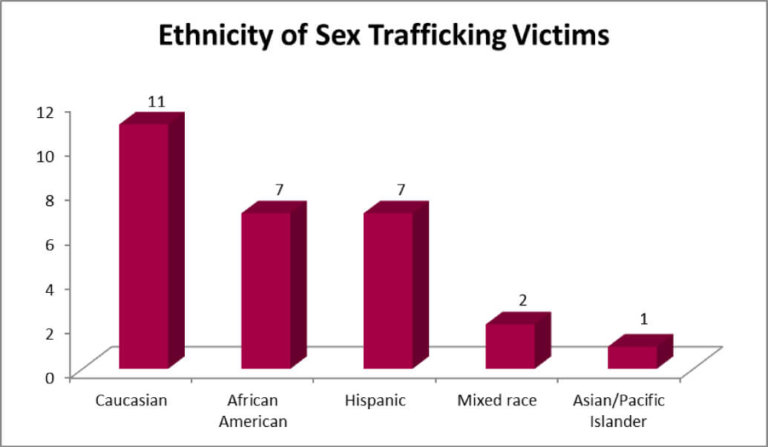
PROBATION TYPE
The 28 sex trafficking victims were assigned to standard probation (19, 67.9%), intensive probation (6, 21.4%), unsupervised probation (2, 7.1%), and pretrial supervision, defendant monitoring unit (1, 3.6%).
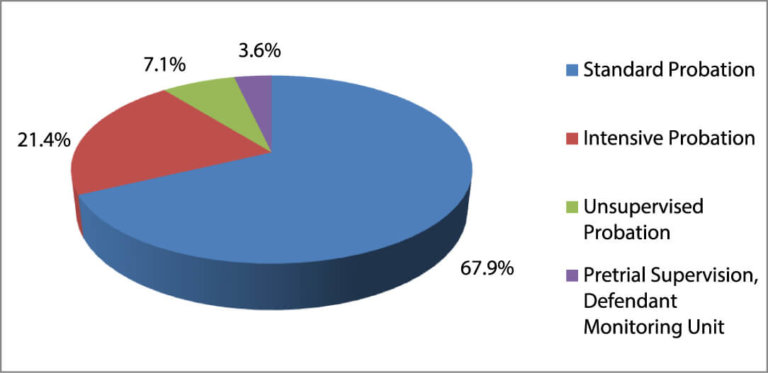
RISK FACTORS
Experiences of the 28 victims identified included more than three quarters being identified as having a substance abuse problem (23, 82.1%), more than a third reported to have a history of sexual abuse (12, 42.9%), moving frequently (13, 46.4%), and homelessness (10, 35.7%), while more than a quarter reported mental health issues (8, 28.6%) and tattoos or branding (7, 25%).
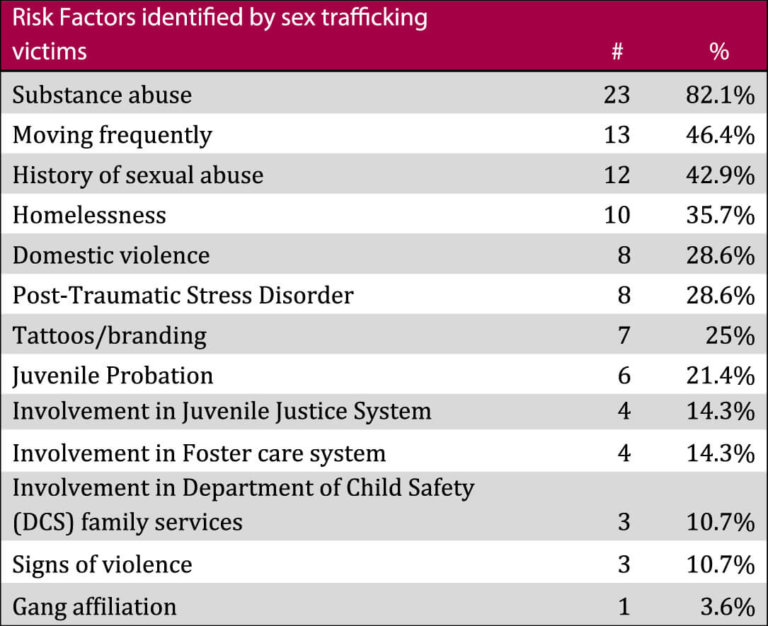
TRAFFICKING SITUATION
The pathway into the sex trafficking situation was described for 20 of the 28 sex trafficking victims. Responses were read carefully and placed into categories of recruitment including: 1) relationship/ boyfriend, 2) drug addiction, 3) family member, 4) financial strain, 5) friend, 6) prior sexual abuse, 7) gang affiliation.
Responses occasionally included more than one category, and were coded into each category represented in the brief narratives provided in response to this question.
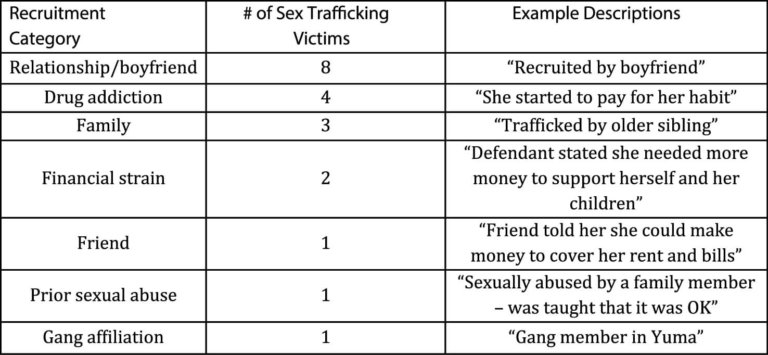
TRAFFICKER RELATIONSHIP TO THE VICTIM
The reported relationship to the person who sex trafficked the victim included boyfriend (13, 46.4%), family member (2, 7.1%), friend (2, 7.1%), stranger (2, 7.1%), gang (1, 3.6%), and drug dealer (1, 3.6%).
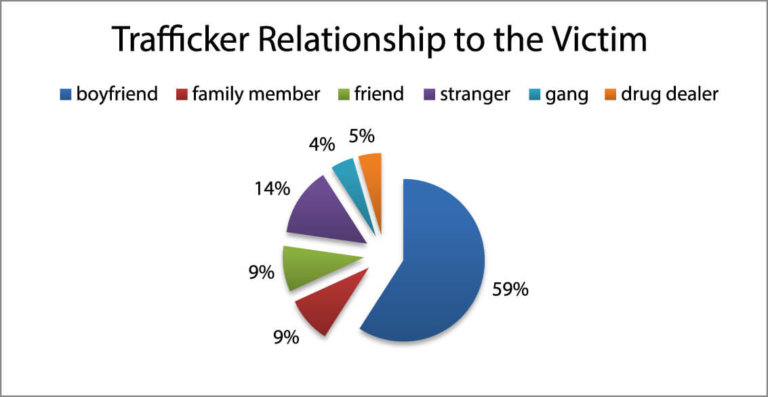
SEX TRAFFICKERS
Of the 121 probation officers who responded to the survey, 32 (26.4%) reported they had a total of 79 unique sex traffickers (a client whom they believed is a trafficker/pimp, who participates in activities of force, fraud or coercion to compel another to exchange sex for something of value) on their current caseloads. Twenty probation officers provided in-depth accounts for 22 of the 79 sex traffickers. The current age of the 22 identified sex traffickers ranged from 19 to 51 (M= 32.3, SD= 9.05), and the average age of entry into sex trafficking ranged from 18 to 34 years (M=22.5, SD= 4.83). The 22 sex traffickers included 14 males (63.6%), 6 females (27.3%), and 2 were missing gender (9.1%)
ETHNICITY
Ethnicity of the sex traffickers included, 12 African American (54.5%), 6 Caucasian (27.3%), 1 Hispanic (4.5%), and 3 were not disclosed (13.6%).
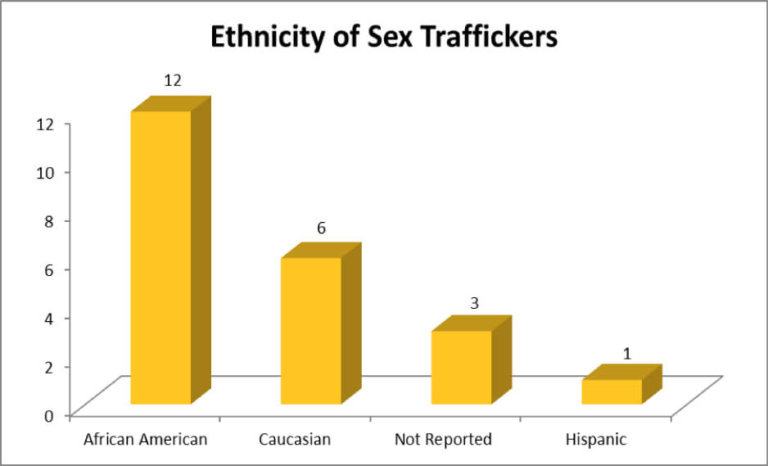
PROBATION TYPE
Probation Officers reported that the 22 sex traffickers were sentenced to standard probation (18, 81.8%), intensive probation (3, 13.6%), and pretrial supervision, electronic monitoring (1, 4.5%).
RISK FACTORS IDENTIFIED
Risk factors reported about the 22 sex traffickers included previous involvement in the Justice System (12, 54.5%), moving frequently (9, 40.9%), tattoos/branding (6, 27.3%), previous involvement in Juvenile Probation (6, 27.3%), and drug/alcohol addiction (18.2%).
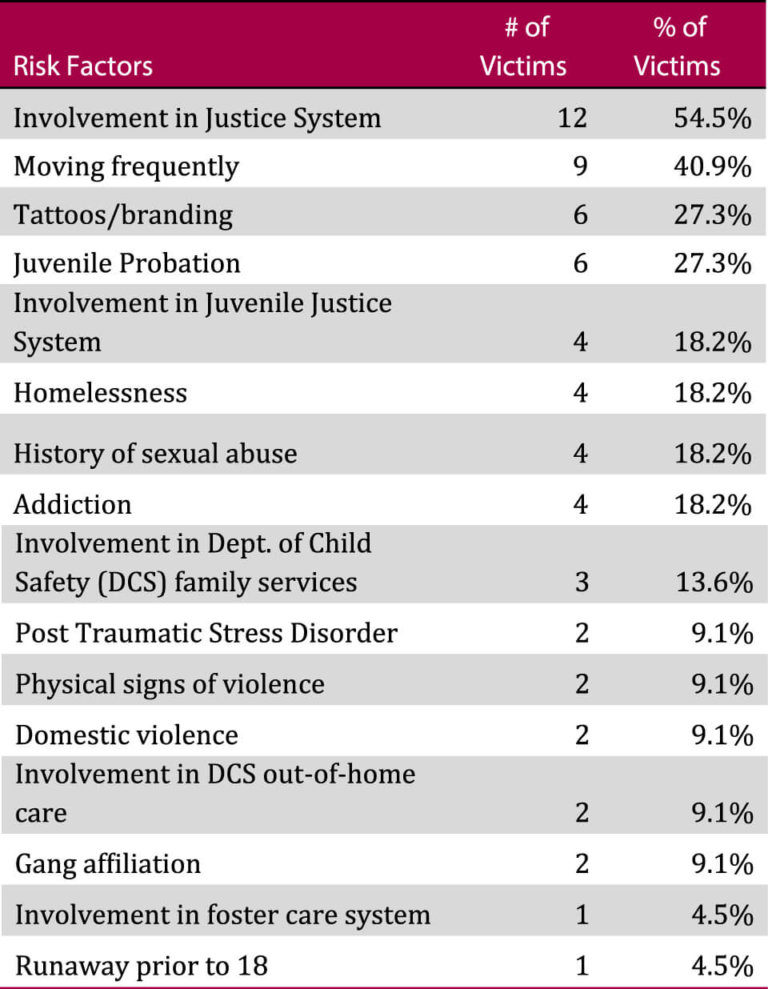
12 PATHWAYS INTO SEX TRAFFICKING SITUATIONS
Responses to the question regarding client’s pathways into sex trafficking were provided for 7 of the 22 sex trafficker cases. Responses were placed into specifically identified pathways of recruitment into sex trafficking situations including: 1) drug addiction, 2) friend, 3) relationship/boyfriend, 4) gang affiliation, 5) former victim. Responses occasionally included more than one category, and were coded into each category represented in the brief narratives provided in response to this question.
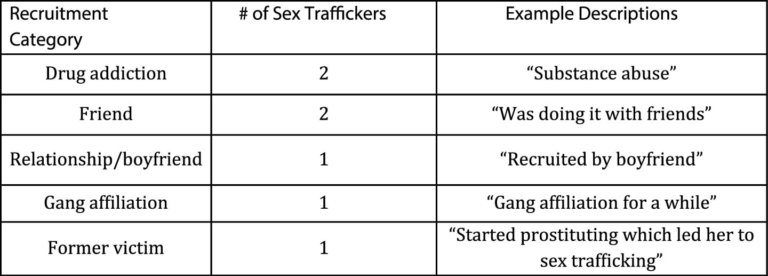
HOW THE SEX TRAFFICKER GOT INVOLVED IN THE CRIMINAL JUSTICE SYSTEM
Sex traffickers were reportedly apprehended through police action (7, 31.8%), being picked up on other charges (7, 31.8%), and turned in by the trafficked victim (2, 9.1%).
DISCUSSION
Prior to this study, the incidence of sex trafficking victims and traffickers on adult probation caseloads was unknown. Overall, these findings suggest that sex trafficking victims and sex traffickers exist within the adult probation system and previously were not identify them through any systematic assessment or flag.
What is the scope of sex trafficking victims and sex traffickers under supervision of Maricopa County Adult Probation during a two-week period in November 2014?
Of the caseloads of the 121 adult probation officers surveyed, sex trafficking victims made up 6.94% and sex traffickers made up 7.1%.
What is the gender, race and age distribution of adults identified as sex trafficking victims currently under supervision by Maricopa County adult probation?
The sex trafficking victims identified in this study were mostly female (92.2%) and were predominantly Caucasian (39.3%), African American (25%) and Hispanic (25%). Sex trafficking victims ranged in age from 16 to 51 years old (M =30.25). This is similar to the average age of the typical client on the caseloads of the adult probation officers who reported sex trafficking victims on their caseloads (M =30.25).
What is the gender, race and age distribution of adults identified as sex trafficking offenders currently under supervision by Maricopa County adult probation?
The sex traffickers reported in this study were primarily male (63.6%), and predominantly African American (54.5%), Caucasian (27.3%) and Mixed Race (13.6%). Sex traffickers ranged in age from 19 to 51 years (M = 32.3). This is similar to the average age of the typical client on the caseloads of the adult probation officers who reported sex traffickers on their caseloads (M =32.25).
What risk factors were identified for sex trafficking victims and sex traffickers that can assist with identifying possible interventions?
Risk factors that were identified for the sex trafficked victims that indicate serious service needs were: substance abuse addiction (82.1%), frequent moves/unstable housing (46.4%) childhood sexual abuse (42.9%), homelessness (35.7%), diagnosis of posttraumatic stress disorder (28.6%), and a history of domestic violence victimization (28.6%).
For the sex traffickers, more than half (54.5%) had previously been involved in the criminal justice system and more than a quarter (27.3%) had been involved in the juvenile justice system. These were opportunities missed to address the issues that propel a person to become a sex trafficker. Substance use addiction was reported for 18.2% of the sex traffickers. Instability of housing/moving frequently was reported for 40.9%, childhood sexual abuse by 18.2%, and homelessness by 18.2%.
Sex Trafficking Victim Treatment Needs
Sex trafficking victim information indicated substance abuse treatment, supportive and stable housing with treatment for sexual abuse, posttraumatic stress disorder and issues related to domestic violence victimization along with the sex trafficking victimization.
Sex Trafficker Treatment Needs
Sex trafficking offender information indicated substance abuse treatment, supportive and stable housing, and early intervention and prevention programs for juvenile offenders.
What are the participant’s recommendations for the adult probation department to do regarding improving the services for persons involved in sex trafficking situations?
The probation officers who attended the four-hour training and participated in the study offered innovative suggestions to improve services for persons in a sex trafficking situation. For instance, probation officers suggested creating screening tools and a flag in the system that would alert an officer that a client on his/her caseload has been in a trafficking situation. Other participants suggested developing programs and providing access to therapeutic services or residential programs as part of the victim’s probation. Programs could assist victims with exiting and deterrence, while programs for traffickers could emphasize re-focus. Probation officers expressed interest in further training opportunities on how to detect trafficking situations, what questions to ask, and finally, what services to offer. Some officers suggested adding a trafficking specific training to the academy. Other suggestions included better communication with law enforcement, the gang unit and field officers, and a trafficking-specific specialized caseload.
LIMITATIONS OF THE STUDY
These findings should be considered with caution regarding generalizing to all adult probationers and adult probation departments. Only 186 (41.9%) of the caseload carrying 444 adult probation officers in Maricopa County were eligible to participate in the study as they met the eligibility requirement of attending the training. The respondents were 65.1% of the eligible sample and 27.3% of caseload carrying adult probation officers in Maricopa County.
Due to the complexities and secrecy that is often a part of sex trafficking situations, some cases of sex trafficking victims and sex traffickers on Maricopa Adult Probation may not have been detected by the surveyed adult probation officers.
RECOMMENDATIONS
There are several recommendations for practice that have emerged from this study: enhancing targeted therapeutic services and deepening the connection between adult probation and law enforcement to combat sex trafficking in our community.
This study has illustrated that there are sex trafficking victims on adult probation in Maricopa County. The training developed for this study appears to have assisted in the enhancing of the sex trafficking specific knowledge of adult probation officers to identify victims of sex trafficking on their caseloads. The next step after identification is to provide necessary services that target the specific problem areas identified in the study: post-traumatic stress disorder, housing challenges, drug and alcohol abuse, and trauma treatment for sexual abuse.
Exiting sex trafficking situations is a complex process and sex trafficking victims are at risk for re-entry for a number of reasons, including: limited employment skills, feeling as if sex trafficking and prostitution is all they know, fear of changing, unresolved trauma, few social supports and role models, economic pressures to support their family, a strong bond to their trafficker, fear of their trafficker, and addiction pressures. The reasons for re-entry into sex trafficking situations can be addressed through targeted therapeutic services, which will need to be developed for adult probationers to access. There are therapeutic services currently available to adult probationers but these do not address issues related to prostitution and sex trafficking which can be enhanced, but developing new interventions are essential in addressing the service needs of these clients.
Two specific therapeutic interventions are recommended to be developed as they may assist sex trafficking victims on adult probation to successfully exit and stay out of the ‘life’. First, a weekly survivor co-led psycho-education group which is focused on issues related to sex trafficking and prostitution would assist in the exiting process for those still struggling to get out of the ‘life’, as well as help those already exited to address their experiences. This group would be open to all adult probationers identified as sex trafficking victims and would provide support and a safe place to talk specifically about their life experiences and sexual exploitation. A second intervention that was identified by the adult probation officers responding to the survey for this study is a safe, secure, therapeutic residential program for women to transition to when they leave jail. This transition point, being released from jail, is a critical waypoint and opportunity to assist victims of sex trafficking to remain away from their trafficker and away from the elements of their life that contribute to re-entry into a sex trafficking situation.
Sex traffickers were also found to have a number of therapeutic needs that if met, may prevent them from continuing to be sexual exploiters. Developing interventions for sex traffickers that address their housing instability, substance abuse issues and delinquency, usually starting as a juvenile, may assist in supporting their exit from the “life”.
Shifting from therapeutic services to a focus on suppressing and intervening in sex trafficking from a community safety perspective, collaboration with law enforcement on known cases has an important role in combating sex trafficking. Maricopa County Adult Probation is a professional, forward-focused agency invested in continuous improvement with commitment from executive leadership to assume a prominent role in the investigation, prevention and suppression of sex trafficking within their area of responsibility. In order to fulfill this role, it is recommended that the agency consider the following:
- Recognize the agency is uniquely placed within the criminal justice system to play a significant role in making a positive impact on sex trafficking investigations and in developing harm reduction strategies for affected victims under their supervision.
- Increase communication between the agency and law enforcement partners within the State of Arizona specific to the subject of sex trafficking.
- Utilize the already effective agency model on gang member intelligence gathering, in a similar fashion to gather intelligence on traffickers and potential victims under their supervision and share as necessary with partner law enforcement agencies.
It is clear from this study that there is much to be gained by increased partnering between law enforcement and the probation system. As two parts of the criminal justice system, law enforcement and probation historically have had distinct roles that appear to be separated by the order of the legal process but are, in fact, connected by the potential for their interdependent role to have a positive effect on sex trafficking in their shared community. For example, once a victim is recovered and a trafficker is held accountable by the court system, that typically tends to end the involvement of the police and begins the involvement of probation. Instead, it is recommended that law enforcement and probation enhance an already positive relationship that is presently more focused on fugitive apprehension following the violation of probation conditions to include a pro-active, reciprocal information exchange regarding those clients involved in sex trafficking as either a victim or a suspect to prevent, identify and intervene.
It is clear that ongoing communication between police and probation would have a positive net effect on slowing the growth of sex trafficking as a community safety issue. Probation officers occupy a unique role in law enforcement that is equal parts enforcement and service provision. As a part of court ordered probation, clients of adult probation are compelled to appear for regular appointments and provide intimate details regarding aspects of their lives that would be of interest to law enforcement during an investigation. Similarly, because of this hybrid position occupied by probation, there appears to be an increased comfort of clients to share details regarding their activities and associations that they may not be as inclined to share with law enforcement.
The training provided to the adult probation officers in this study included an in-depth 17 review of criminal street gang investigations and tactics, specifically covering intelligence gathering as a means to further or enhance criminal or probation investigations. This was used as an introduction to illustrate that the investigative tactics currently used in gang investigations can be equally effective in trafficking investigations, provided there exists the opportunity to effectively share this information and intelligence with law enforcement partners. Among the key means to share gang intelligence is through the completion of a Gang Member Identification Criteria (GMIC) form, a statutorily defined means of documenting an individual as a gang member. GMIC forms are entered into a regional database called GANGNET that is managed for Arizona law enforcement by the Arizona Department of Public Safety and is dependent upon participating agencies to provide data.
As part of their routine caseload, many probation officers regularly interact with documented and alleged gang members and recognize the value of gang intelligence as a critical piece in holding their probationers accountable and in assuring officer safety while conducting fieldwork. Common pieces of gang intelligence collected by probation officers include self-declarations of gang affiliations, photos depicting gang signs or colors and social indicators of gang associations, each of which are used as a means to enforce probation terms and in locating probationers who abscond once failing to meet these terms. Such information is invaluable to both probation officers and law enforcement investigators.
CONCLUSION
As part of its continuing effort to lead the nation in advancing the practice of probation and in ensuring the highest level of services are provided to their probationers, the office of Maricopa County Adult Probation is moving towards an enhanced understanding of sex trafficking, its effect on community safety within the county and its unique role in combatting it through developing targeted therapeutic services, and partnering with law enforcement. The goal of this training was to increase the ability of probation officers, surveillance officers and caseworkers to recognize the indicators of sex trafficking and to provide the means to identify and support its victims and deter sex traffickers who are under their supervision.
Through the thoughtful interviewing of the victims and offenders of sex trafficking, it is further believed members of adult probation will both be able to provide targeted sex trafficking interventions as well as develop crucial information on sex traffickers. As both law enforcement and service provider, probation officers in Maricopa County are especially well positioned to play a prominent role in fighting sex trafficking and identifying those who would benefit from therapeutic services and those who promote and engage in it.
REFERENCES
Carey, C, & Teplitsky, L. (2013). Commercial Sexual Exploitation of Children (CSEC) in the Portland Metro Area.
http://www.justice.gov/usao/or/downloads/the_csec_report.pdf
Carlson, B., & Shafer, M. (2010). Traumatic histories and stressful life events of incarcerated parents: Childhood and adult trauma histories. The Prison Journal, 22, 1-19.
Covenant House (2013). Homelessness, survival sex, and human trafficking: As experienced by the youth of Covenant House New York.
http://www.covenanthouse.org/sites/default/files/attachments/Covenant-House-trafficking-study.pdf
Maricopa County Superior Court (2014). Make Big Changes in Small Steps. Maricopa County Adult Probation: 2014 Annual Report. https://www.superiorcourt.maricopa.gov/adultprobation/docs/2014AnnualReport.pdf).
Perdue, T., Williamson, C., Ventura, L., Hairston, T., Osborne, L.et al (2012). Offenders who are mothers with and without experience in Prostitution: Differences in historical trauma, current stressors, and physical and mental health differences. Women’s Health Issues, 22, 195-200.